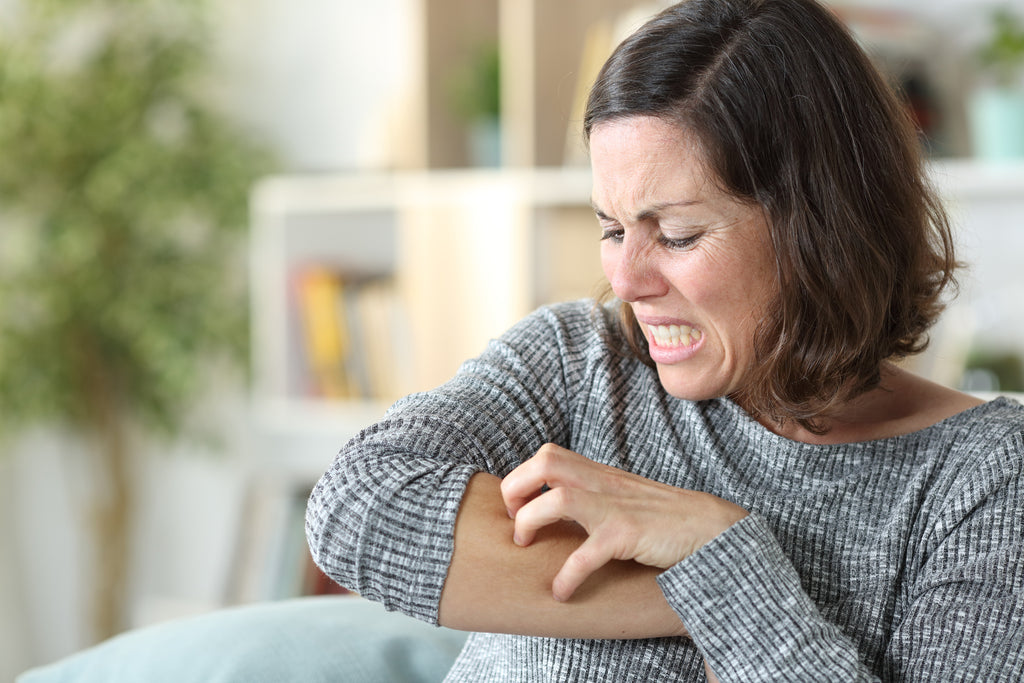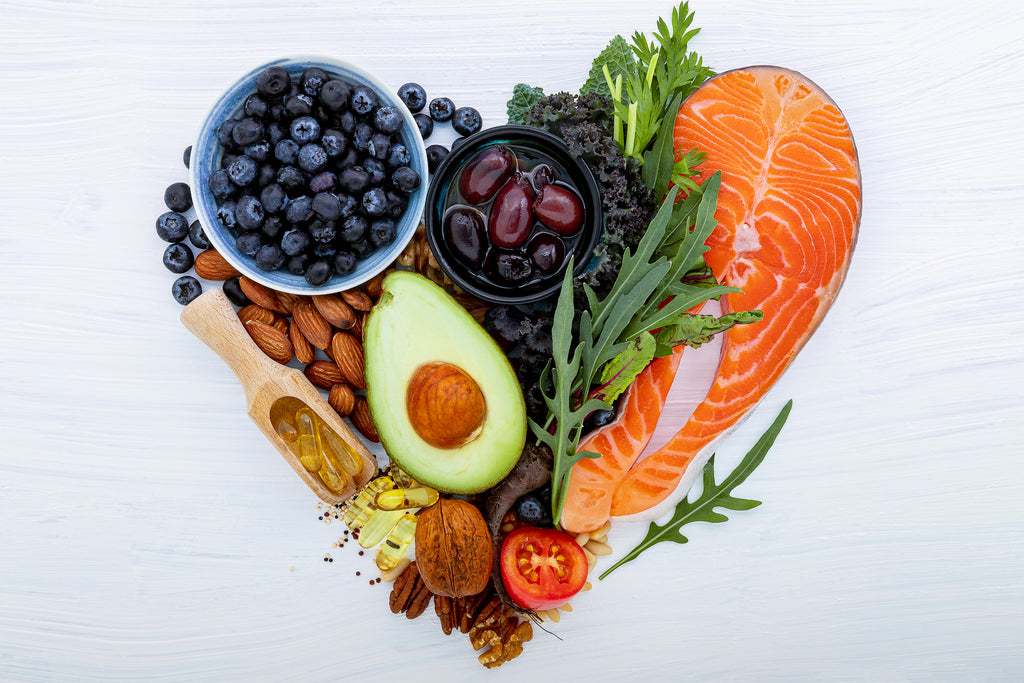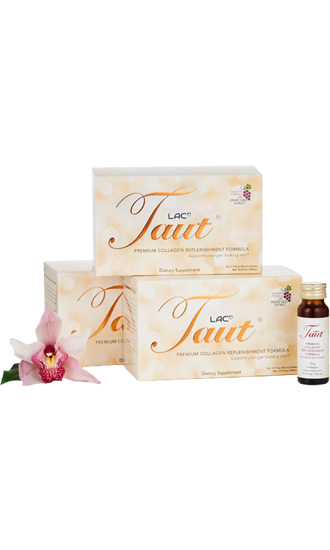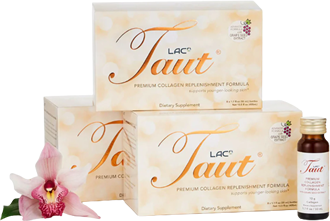Skin Blemishes: How to Get Rid of a Blemish on Your Face (Different Types)

There’s nothing worse than waking up to an unexpected blemish on your face. Whether it’s a pimple, blackhead, ingrown hair, or a persistent deepening wrinkle, it’s always unwelcome.
Unfortunately that “oh no, not again!” moment can happen more and more often as we age if we don’t properly take care of our skin's overall health and wellness.
If you find yourself discovering continued imperfections on your skin, wondering how and why it keeps happening, you can take comfort in the fact that you are not alone. The reality is that most people don’t wake up with red carpet radiance and youthful skin!
Loss of skin elasticity, wrinkles, age spots, pimples, uneven skin tone, and cellulite are common blemishes and a universal experience for women. These blemishes affect all kinds of people and many different types of skin.
The good news is, no matter what’s causing your latest blemish, it is possible to prevent and treat them with some serious skincare.
In this article, we'll take a look at the most common types of skin blemishes, what causes them, and how to effectively treat them.
7 Types of Skin Blemishes
Skin imperfections may occur naturally, but that doesn’t mean they’re welcome on your skin. Knowing the types and causes of your skin blemishes is the first step toward preventing and treating them. Below are several common causes of imperfections and the effects they have on your skin.
1. Acne
If you are struggling with acne-related blemishes, you’re not the only one. Acne is a very common skin condition. 50 million American people suffer from acne each year, and it’s not only affecting teenagers with oily skin types. Up to 15% of women will experience adult acne in later life.1
It is caused by a build-up of oil, bacteria, or dirt that clogs large pores. This build-up leads to spotty types of blemishes like blackheads and whiteheads.
Excess sebum production from the oil glands is also a characteristic of acne, leading to shiny or greasy-looking skin.
You might suffer from occasional acne-like breakouts, or you could suffer from a more severe and persistent form of breakouts diagnosed as acne vulgaris.
Acne vulgaris is a medical condition, characterized by more severe and inflamed blemishes. These can include papules (red, tender spots), pustules (oil- or pus-filled pimples), nodules (larger inflamed lumps), and cysts, which will most likely need to be medically reviewed in order to receive the correct medical advice, diagnosis, and treatment.
Unfortunately, there are a huge variety of factors that can play a part in acne breakouts, one of which is diet. High sugar foods are a common cause of acne breakouts so watch your diet if you struggle with pimples.

2. Hyperpigmentation
Hyperpigmentation is the appearance of dark patches on the face and body. It is caused by a build-up of melanin deposits on the skin.
Age spots or liver spots are a common form of hyperpigmentation, these are small dark spots that appear most commonly on the face and hands where your skin is most exposed to the sun. Age spots are a type of blemish that commonly occur in people over the age of 40, but they can appear sooner if you spend too much time in the sun without proper protection.
Too much time in the sun can also be very damaging to your skin's health and wellness, leading to diseases such as skin cancer if your skin is not properly protected. If you find any suspicious dark spots that may be a sign of skin cancer, be sure to have them medically reviewed to be on the safe side.
Melasma is another common skin blemish caused by hyperpigmentation, which you may be familiar with if you have been pregnant before. Melasma is the darkening of your skin color in certain areas, most commonly around the eyes and mouth. This blemish is caused by hormonal changes and is very common among pregnant women – so much so that it is commonly referred to as the “mask of pregnancy.”
3. Rosacea & Redness
Redness in the face is an embarrassing and often uncomfortable skin blemish that you often can’t control.
Redness in the face is often caused by irritation of the skin, which may be thanks to harsh skincare products, allergies, or too much sun exposure. Many people also experience flushing and redness in reaction to spicy foods or alcohol.
Rosacea is a skin condition characterized by redness in the face and visible blood vessels, which can cause particularly flushed cheeks, a red rash, swelling, bumps, and red spots. Treatment for rosacea is possible, but there is no cure.
4. Stretch Marks & Cellulite
Stretch marks and cellulite are common blemishes that occur around the thighs, hips, and stomach, and they can be very hard to get rid of.
Stretch marks are a type of blemish that occurs when our skin is put under stress and stretched thin, such as when we grow or gain weight. When our skin elasticity declines with age, hormonal changes can also cause a weakening of the skin structure which leads to stretch marks.
Cellulite is a type of skin blemish that most women will be familiar with! Cellulite is caused by a build-up of fat cells that then push against the skin, causing lumps and bumps, white lines, and dimples.

5. Fine Lines & Wrinkles
Fine lines and wrinkles are universal concerns among all different types of skin.
As we age, we lose moisture and elasticity in our skin which is caused by a decline in levels of collagen, elastin, and hyaluronic acid in our bodies. Our skin condition declines and we begin to lose the structure that holds it in place, causing wrinkling and sagging.
Laughter lines and crow’s feet are common examples of fine lines on the face, where deeper set wrinkles tend to form around the forehead.
6. Ingrown hairs
Ingrown hairs are a type of blemish that initially appear as small red bumps around your hair follicles, typically after using hair removal techniques such as shaving, plucking, or waxing.
They occur when hair follicles are irritated by hair removal, leading to swelling around the follicle that can then block your new hairs from growing correctly. When a new hair gets caught and bent inwards beneath a swollen area, it becomes an ingrown hair.
These ingrown hairs can leave a bump on your skin which can become a cyst if you’re not careful! If this happens, be sure to have the cyst medically reviewed by a doctor in order to get the proper diagnosis or treatment.
7. Psoriasis & Eczema
Psoriasis and eczema are both conditions that cause chronic itchy and dry skin. Aside from the discomfort they cause, they can also leave you with some unsightly blemishes on your face and body.
Psoriasis is characterized by a raised red rash covered with silver or white flaking skin.
Eczema, otherwise known as atopic dermatitis, causes a red rash and very dry skin. It can cause thick patches of skin rash, with itchy raised bumps that can sometimes leak fluid or form crusts on the skin.
If you are experiencing a chronic red rash, you should have it medically reviewed by a doctor to find out what the underlying cause is.

What Causes Skin Blemishes? (& How To Prevent Them)
We believe that prevention is always better than cure when it comes to blemishes on the face and body, so it’s important to understand what causes these imperfections and consider how we can prevent them in the future.
Now that we’ve identified the most common types of blemish, let’s take a look at the main causes of these skin concerns.
1. Sun Damage
If you’re a big fan of sunning yourself at the beach, it might be time to swap that tanning oil for a good SPF cream!
Over time, sun exposure causes permanent damage to our skin’s structure. And we’re not just talking about sunburn or heat rash.
The sun emits UVA and UVB rays which cause irreparable damage to the dermis. This damages our collagen and elastin supplies, which leads to fine lines and wrinkles, uneven skin tone, dryness, hyper-pigmentation, and age spots. With continued or excess sun exposure, these imperfections can continue to worsen, and they can even lead to the development of precancerous cells – which are the precursors for skin cancer.
So make sure you protect your skin against skin cancer and other blemishes with a high SPF every day – we recommend factor 30 or higher. Remember that even if it’s not a hot sunny day, the sun’s rays can still cause damage to your skin.
If you find any suspicious moles or severe sun damage, these are often benign but they can potentially be the early signs of skin cancer, so you should make sure it is medically reviewed by a dermatologist or doctor.
2. Poor Nutrition
Because your body needs adequate nutrients to keep cells healthy and fight the buildup of waste inside our bodies, poor nutrition can cause age spots, patchiness, and dull, uneven skin tone.
So make sure you get a good balance of vitamins, minerals, antioxidants, and healthy fats in your diet for optimal skin health. You can seek medical advice from a nutritionist or registered dietician if you want to find a tailored meal plan specific to your concerns and needs.
Additionally, not drinking enough water can wreak havoc on your skin. Dehydrated skin can be more prone to acne, wrinkles, irritation, and skin conditions.

3. Viral & Bacterial Infections
Inadequate nutrition can also lead to a weakened immune system, as your body needs a full complement of vitamins and minerals to fight off viruses and infections. Failure to stave off these viruses and infections can lead to skin blemishes like cold sores or warts.
Cold sores are caused by the herpes simplex virus, and the bad news is that once you have caught this virus you are likely to suffer from outbreaks of cold sores throughout your life.
Bacterial and yeast infections can also cause nasty blemishes like fungal acne, pustules, and warts.
If you are suffering from any skin conditions associated with infection, be sure to have them medically reviewed by a doctor and gather the right health information to help you find the proper treatments. The content of this article is for informational purposes only, only a doctor or dermatologist can properly assess your needs, prescribe proper treatment, and rule out skin cancer.
4. Hormone Variations
When you experience hormone variations and stress, your skin can respond in a number of ways, including breakouts, uneven skin tone and texture, hyperpigmentation, and lines and wrinkles.
Hormonal changes during menopause can cause your skin to become thin, dry, and prone to sagging.
Pregnancy causes estrogen levels to spike significantly in the body, in order to aid the development of the baby in the womb. However, this also causes severe dry skin and even an uncomfortable rash or two. The hormone changes in pregnancy can also bring melasma, hyperpigmentation, and stretch marks.
Stress leads to a spike in cortisol, which can cause acne, blackheads and whiteheads, excess oil production, and even the dreaded itchy stress rash.
Although blemishes due to hormonal fluctuations are not always preventable, there are some proactive actions you can take to manage your stress. Try some relaxation techniques such as mindfulness, yoga, or journaling to boost your happy hormones and reduce the blemishes associated with high cortisol levels.
5. Genetics
Many people will find that their blemishes are caused by hereditary conditions, so if your mom or dad suffered from any particular skin complaints, there’s a chance you will too.
Eczema, psoriasis, and rosacea can all be inherited by your genes, so these conditions often need managing and treatment rather than prevention. They may also need to be medically reviewed by a professional and treated with prescription skincare.
6. Free Radical Damage
You know that smoking and drinking alcohol are both habits that wreak havoc on your skin, but did you know polluted air and harsh city environments could have a similar impact?
This is all thanks to something known as free radical damage. Free radicals are unstable atoms that form in our bodies when we expose our systems to toxins like smoke, alcohol, or pollution, and they cause damage at a cellular level.2
Free radicals work to deplete our collagen content, and they can even lead to major health issues like skin cancer, diabetes, and heart disease over time.
If you’re not careful to protect your skin properly from free radical damage, your skin can become saggy, dull, and dry, with lines, wrinkles, and hyperpigmentation that could have been prevented. So try to minimize your drinking and smoking habits, protect your skin from environmental pollutants, and choose skincare products that contain antioxidants to fight against free radical damage.
How Can You Treat Skin Imperfections?
While prevention is ideal, it’s not always possible. Luckily, there are plenty of treatments available to reduce skin imperfections once you start to see those telltale signs of damage to your skin.
Look for the following ingredients and treatments to brighten your skin, reduce the appearance of fine lines, wrinkles, and blemishes, and help your skin return to the luminous, blemish-free complexion you remember.

1. Benzoyl Peroxide
Benzoyl peroxide is the most common ingredient used in many different acne treatments, as it is effective in reducing the excess oil, bacteria, blackheads, and other blemishes caused by acne.
This ingredient kills bacteria underneath the epidermis, exfoliates and removes dead skin cells, and reduces excess sebum production. It is even effective in reducing the appearance of acne scars.
You’ll find it in anti-acne cleansers or cream treatments that can be purchased over-the-counter (OTC) at your local pharmacy.
2. Retinoids
Retinoids are another family of ingredients that are used to treat severe cases of acne, and they are most often found in more potent oral acne medications that need to be medically reviewed and prescribed by a doctor.
Retinoids are derivatives of vitamin A, and treatments with a potent retinoid content are effective in unclogging pores, removing dead skin cells, and reducing the appearance of acne scars. You can find retinoids in the form of retinol, tretinoin, adapalene, or isotretinoin, the latter being the active ingredient in the popular acne medication Accutane.
People with sensitive skin types should avoid using retinoids as they can potentially irritate the skin, although you can always speak to your doctor for some medical advice and to find suitable anti-blemish products for your needs.
3. Salicylic Acid
Salicylic acid belongs to a family of acids known as BHAs (beta hydroxy acids), and it is another great ingredient for treating a whole range of skin blemishes, including acne and hyperpigmentation.
It works as an exfoliant to remove dead skin cells and unclog pores, and you can find it in various serums and exfoliating skincare products.
It is also a common ingredient used at a higher potency in chemical peels, which many people like to use to treat sun damage, remove dark spots, and improve skin tone and texture.
This acid is another ingredient that can potentially irritate a sensitive skin type, so people with sensitive skin should avoid using it before doing a patch test.
4. Antioxidants
Antioxidants are profoundly effective for both preventing and treating cellular damage and helping to promote healthier, younger-looking skin.
The most potent and skin-loving antioxidant you should look for is L-Glutathione, the mother of all antioxidants.
Glutathione is a protein found inside every cell of your body. This protein is a powerful antioxidant, detoxifying and protecting cells from free radicals and oxidative stress and boosting the immune system. Studies show glutathione is effective for treating some forms of liver disease, as well as reducing the appearance of liver spots on your skin.3
This protein reduces the look of hyperpigmentation and promotes skin brightening, for a youthful and radiant glow.
Olive Leaf Extract is another powerful ingredient that is scientifically proven to contain more than 20 polyphenolic antioxidants, which are highly effective for neutralizing free radicals. Some polyphenols have been shown to have antiviral, antimicrobial, and neuroprotective properties, while others could help lower blood pressure.4
There’s even evidence that olive leaf extract could inhibit the progression or development of some cancers. Overall, this ingredient in skincare treatments reduces cell degradation and prevents signs of aging by protecting your skin cells.5
Treat The First Signs Of Aging & Brighten Your Skin With Taut Bright
When you’re researching supplements with high-quality ingredients to help protect your skin and encourage the natural elimination of toxins, look for products that contain as many of the skin-loving antioxidants listed above.
Taut Bright contains 7 powerful antioxidants and active ingredients to help brighten your skin, even your skin tone and texture, as well as fight signs of cell degradation.
Along with L-Glutathione and Olive Leaf extract (the potent antioxidants mentioned above), Taut Bright also includes artichoke leaf extract, which has been shown to benefit the liver, helping to protect it and promote proper liver function.6
This powerful formula also includes alpha-lipoic acid, which supports glutathione levels in the body. This combination of potent antioxidants and supporting ingredients works together in your body to improve the look of skin imperfections caused by free radical damage.
Over time, age and environmental factors may leave their mark on your skin, but you can fight it with Taut Bright. Just two capsules a day gives you a powerful dose of antioxidants, supporting your skin’s natural protective qualities and leaving you with brighter, more even, luminous skin.
5. Vitamin C
A well-known antioxidant commonly used to help brighten the skin, this ingredient also protects the skin from free radical damage and supports your natural collagen production.
Vitamin C is effective at preventing some blemishes on the face caused by sun exposure, and it can be used to treat existing blemishes such as fine lines and wrinkles, dark spots, acne scars, and hyperpigmentation.
Soothe & Nourish Tired Skin With Taut Collagen Mask
Looking for a luxurious treatment for sun-damaged, dry, or tired skin?
Taut Collagen Mask is the perfect way to repair and refresh your skin after a long and stressful day. Simply apply the sheet mask, relax for 15 to 20 minutes, and let the rich and soothing collagen essence get to work at reducing the effects of stress, pollutants, and aging on your skin.
Our collagen mask is packed with vitamin C, hydrolyzed marine collagen peptides, and hyaluronic acid which all work together to plump, firm, and hydrate your skin.
It is effective at soothing irritated or damaged skin, reducing the appearance of blemishes, and many people love using it after micro-needling, micro-dermabrasion, or to help heal facial wounds.
6. Collagen Peptides
As we have mentioned in this article, many of the best skincare treatments for blemishes and wrinkles will have a high antioxidant content that supports your collagen production. But did you know that you can go one step further and supplement your skin with collagen peptides?
Collagen peptides can be found in skincare supplements, which you can take orally to trigger your body into producing more collagen and improve your skin’s texture and appearance from the inside out.
By increasing your body's collagen content, you can treat many different types of blemishes on the face and body. Collagen peptides are particularly effective at reducing the appearance of fine lines and wrinkles, but they can also help improve your skin tone and texture for a more radiant, youthful glow. You can also ask your local dermatologist about collagen facials if you're interested in topical solutions.
Here's Our Secret To Smooth, Radiant Skin With Fewer Blemishes
Our Taut Collagen Anti-Oxy Foxy Kit combines the benefits of marine collagen peptides with powerful antioxidants in one easy-to-use bundle that can transform your skin and nourish your body.
It contains a 24-day supply of Taut Liquid Collagen, our premium advanced formula collagen drink that works to slow down and reduce the signs of aging. By supercharging and replenishing your body's collagen, elastin, and hyaluronic acid, Taut Liquid Collagen can boost elasticity, lift and tone sagging skin, and minimize the appearance of scars, stretch marks, and eczema.
The kit also contains Masquelier's French Pine Bark Extract, an antioxidant supplement that is significantly more powerful than vitamin E and 20 times more powerful than vitamin C. By neutralizing free radicals and eliminating toxins, this skin-loving formula protects your collagen content and elastin supplies and improves skin's suppleness and tone. It can also work for your whole body to strengthen blood vessels, improve circulation, and minimize varicose veins.
Together, the hero products in our Anti-Oxy Foxy Kit can help protect against common skin imperfections while working to repair existing damage, for a rejuvenated complexion that's ready to take on the world!
References:
- Statistics and Facts on Dermatology and Skin Conditions
- How do free radicals affect the body?
- Efficacy of Glutathione in Treating Nonalcoholic Fatty Liver Disease
- Effects of the Olive-Derived Polyphenol Oleuropein on Human Health
- Evidence to Support the Anti-Cancer Effect of Olive Leaf Extract and Future Directions
- Pharmacological Studies of Artichoke Leaf Extract and Their Health Benefits






